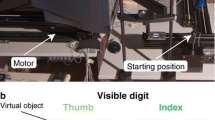Abstract
Reach-to-grasp movements performed without visual and haptic feedback of the hand are subject to systematic inaccuracies. Grasps directed at an object specified by binocular information usually end at the wrong distance with an incorrect final grip aperture. More specifically, moving the target object away from the observer leads to increasingly larger undershoots and smaller grip apertures. These systematic biases suggest that the visuomotor mapping is based on inaccurate estimates of an object’s egocentric distance and 3D structure that compress the visual space. Here we ask whether the appropriate visuomotor mapping can be learned through an extensive exposure to trials where haptic and visual feedback of the hand is provided. By intermixing feedback trials with test trials without feedback, we aimed at maximizing the likelihood that the motor execution of test trials is positively influenced by that of preceding feedback trials. We found that the intermittent presence of feedback trials both (1) largely reduced the positioning error of the hand with respect to the object and (2) affected the shaping of the hand before the final grasp, leading to an overall more accurate performance. While this demonstrates an effective transfer of information from feedback trials to test trials, the remaining biases indicate that a compression of visual space is still taking place. The correct visuomotor mapping, therefore, could not be learned. We speculate that an accurate reconstruction of the scene at movement onset may not actually be needed. Instead, the online monitoring of the hand position relative to the object and the final contact with the object are sufficient for a successful execution of a grasp.







Similar content being viewed by others
References
Bingham G, Coats R, Mon-Williams M (2007) Natural prehension in trials without haptic feedback but only when calibration is allowed. Neuropsychologia 45:288–294. doi:10.1016/j.neuropsychologia.2006.07.011
Bozzacchi C, Domini F (2015) Lack of depth constancy for grasping movements in both virtual and real environments. J Neurophysiol. doi:10.1152/jn.00350.2015
Bozzacchi C, Volcic R, Domini F (2014) Effect of visual and haptic feedback on grasping movements. J Neurophysiol 112:3189–3196. doi:10.1152/jn.00439.2014
Bradshaw MF, Parton AD, Glennerster A (2000) The task-dependent use of binocular disparity and motion parallax information. Vis Res 40:3725–3734
Campagnoli C, Volcic R, Domini F (2012) The same object and at least three different grip apertures. J Vis 12(9):429
Carlton LG (1981) Processing visual feedback information for movement control. J Exp Psychol Hum Percept Perform 7:1019–1030
Connolly JD, Goodale MA (1999) The role of visual feedback of hand position in the control of manual prehension. Exp Brain Res 125:281–286
Domini F, Caudek C (2013) Perception and action without veridical metric reconstruction: an affine approach. In: Shape perception in human and computer vision. Springer, London, pp 285–298
Flanders M, Helms Tillery S, Soechting JF (1992) Early stages in a sensorimotor transformation. Behav Brain Sci 15:309–320
Foley JM (1980) Binocular distance perception. Psychol Rev 87:411–434
Fukui T, Inui T (2013) Utilization of visual feedback of the hand according to target view availability in the online control of prehension movements. Hum Mov Sci 32:580–595
Goodale MA, Jakobson LS, Keillor JM (1994) Differences in the visual control of pantomimed and natural grasping movements. Neuropsychologia 32:1159–1178
Graham JK, Bradshaw MF, Davis A (1998) The effect of pre-movement delays on pointing accuracy in middle childhood. Perception 27:1379–1387
Harris CS (1965) Perceptual adaptation to inverted, reversed, and displaced vision. Psychol Rev 72(6):419–444. doi:10.1037/h0022616
Harris CS (1974) Beware of the straight-ahead shift—a nonperceptual change in experiments on adaptation to displaced vision. Perception 3(4):461–476
Heath M, Binsted G (2007) Visuomotor memory for target location in near and far reaching spaces. J Mot Behav 39:169–177
Hecht H, van Doorn A, Koenderink JJ (1999) Compression of visual space in natural scenes and in their photographic counterparts. Percept Psychophys 61:1269–1286
Hibbard PB, Bradshaw MF (2003) Reaching for virtual objects: binocular disparity and the control of prehension. Exp Brain Res 148:196–201. doi:10.1007/s00221-002-1295-2
Hu B, Knill DC (2011) Binocular and monocular depth cues in online feedback control of 3D pointing movement. J Vis 11:1–13. doi:10.1167/11.7.23
Jakobson LS, Goodale MA (1991) Factors affecting higher-order movement planning: a kinematic analysis of human prehension. Exp Brain Res 86:199–208
Jeannerod M (1984) The timing of natural prehension movements. J Mot Behav 16:235–254
Ma-Wyatt A, McKee SP (2007) Visual information throughout a reach determines endpoint precision. Exp Brain Res 179(1):55–64
Milner AD, Ganel T, Goodale MA (2012) Does grasping in patient DF depend on vision? Trends Cogn Sci 16:256–257
Nicolini C, Fantoni C, Mancuso G, Volcic R, Domini F (2014) A framework for the study of vision in active observers. In: Rogowitz BE, Pappas TN, de Ridder H (eds) Proceedings of SPIE 9014, human vision and electronic imaging. Bellingham, WA, SPIE, 2014, 901414
Schenk T (2010) Visuomotor robustness is based on integration not segregation. Vision Res 50:2627–2632
Schenk T (2012) No dissociation between perception and action in patient DF when haptic feedback is withdrawn. J Neurosci 32:2013–2017
Schot WD, Brenner E, Smeets JB (2010) Robust movement segmentation by combining multiple sources of information. J Neurosci Methods 187:147–155
Smeets JB, van den Dobbelsteen JJ, de Grave DD, van Beers RJ, Brenner E (2006) Sensory integration does not lead to sensory calibration. Proc Natl Acad Sci USA 103:18781–18786
Volcic R, Domini F (2014) The visibility of contact points influences grasping movements. Exp Brain Res 232:2997–3005. doi:10.1007/s00221-014-3978-x
Volcic R, Fantoni C, Caudek C, Assad JA, Domini F (2013) Visuomotor adaptation changes stereoscopic depth perception and tactile discrimination. J Neurosci 33(43):17081–17088
Westwood DA, Heath M, Roy EA (2003) No evidence for accurate visuomotor memory: systematic and variable error in memory-guided reaching. J Mot Behav 35:127–133. doi:10.1080/00222890309602128
Whitwell RL, Lambert LM, Goodale MA (2008) Grasping future events: explicit knowledge of the availability of visual feedback fails to reliably influence prehension. Exp Brain Res 188:603–611. doi:10.1007/s00221-008-1395-8
Author information
Authors and Affiliations
Corresponding author
Rights and permissions
About this article
Cite this article
Bozzacchi, C., Volcic, R. & Domini, F. Grasping in absence of feedback: systematic biases endure extensive training. Exp Brain Res 234, 255–265 (2016). https://doi.org/10.1007/s00221-015-4456-9
Received:
Accepted:
Published:
Issue Date:
DOI: https://doi.org/10.1007/s00221-015-4456-9




